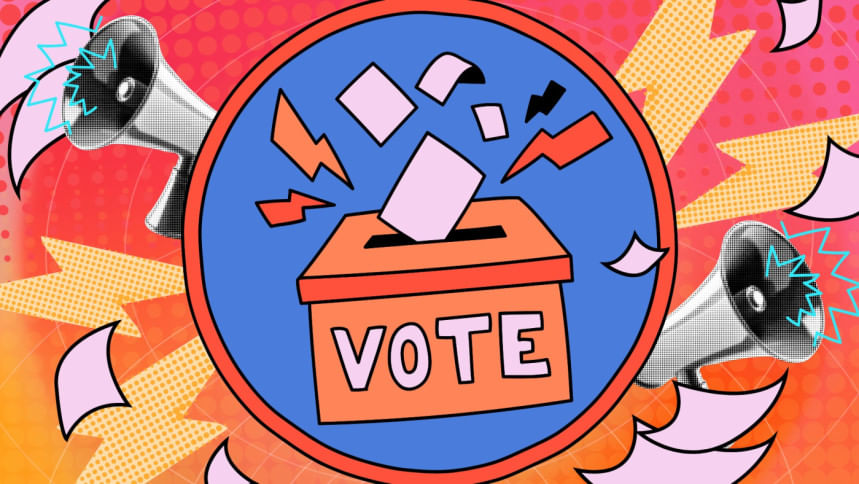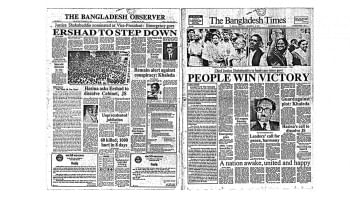Elections: Explained

In Bangladesh right now, it's hard to go a week without hearing about elections. Whether it's on the news, in a heated tea stall debate, or on your social media feed, the topic is the centre of the political climate. At first glance, the idea seems simple: people drop slips of paper into a box, the person with the most votes wins, and a new government is formed. Easy, right? Not really. While that's the basic idea, elections are more complex, and more consequential. They are one of the core rituals of democracy, the process through which many societies today decide who leads, which policies matter, and how power is shared.
At its simplest, an election is a process where people cast votes to make collective decisions. Instead of power being seized by force or inherited by bloodline, it's transferred peacefully through ballots. Beyond government, elections also show up in our everyday lives through student councils, unions, and residential societies. The principle is the same: when more than one voice needs to be heard, an election helps decide fairly.
Imagine your school is holding an election for student council positions. Perhaps a friend of yours chooses to run, and each class nominates a candidate.
Some candidates focus on improving the library, or sports facilities, while others promise small but meaningful changes, like pushing for a five-minute longer recess so students don't have to rush their lunch. On voting day, every student casts a ballot for the candidate they believe will best represent them. Even in this small-scale election, the process mirrors a national one: there's campaigning, competition, voter choice, and ultimately, a decision that impacts the community. Throughout this article, we'll keep this school election in mind, using it to show how elections work, why voting matters, and how systems of representation, campaigning, and fairness play out in real life.
Not all elections look alike. National elections usually decide who governs a country, that is, presidents, parliaments, or prime ministers. Local elections focus on mayors, councils, or school boards. Sometimes, citizens vote directly on issues rather than candidates, through referendums.
Each has its own rules, but the underlying idea is participation. Every election starts with a simple but important question: who gets to vote? Not everyone automatically has that right. In national elections, there are certain requirements pertaining to one's age, citizenship, or residency. In our school election, this could mean that only the students who are currently enrolled, and above a certain age or grade, can vote. This ensures the decision reflects the voices of those who are directly affected by it.
Voting itself usually means paper slips dropped into a box, or it might be electronic machines or online systems. The key is that every eligible voter has a safe and private way to make their choice.
But, after the campaigning and voting, how is the winner decided?
First past the post (FPTP)
This is the simplest system: whoever gets the most votes wins. Imagine your school election has three candidates: A, B, and C. Candidate A gets 40 votes, B gets 35, and C gets 25. Candidate A wins, even though 60 students voted for someone else. It's quick and easy, but it can leave a majority feeling unrepresented, especially if the winner didn't get more than half of all votes.
Proportional representation (PR)
PR tries to make results more reflective of everyone's preferences. Imagine four class representative spots are being contested, and three candidates are competing. If Candidate A's supporters make up 50% of the voters, they get two seats; Candidate B's supporters, 25%, get one seat; Candidate C's supporters, also 25%, get one seat. This way, the makeup of the council could better mirror the student body's opinions.
Ranked-choice voting (RCV)
Ranked-choice voting allows voters to rank candidates by preference. Suppose no candidate wins a majority initially. The one with the fewest first-choice votes is eliminated, and their votes are redistributed to each student's second choice. In our school example, if Candidate C is eliminated first, the students who voted for C now see their votes go to their next preferred candidate. This continues until someone reaches a majority. RCV ensures the winner has broader support and isn't just someone who got a simple plurality.
This shows that when it comes to elections, the rules of the game matter as much as the votes themselves. Which system is chosen can change who wins, how campaigns are run, and how fairly the community feels represented.
Before votes are cast, candidates campaign, which typically involves giving speeches, joining debates, flooding social media feeds, or knocking on doors. Campaigns require organisation, money, and media attention. Parties try to inspire loyalty, while candidates frame themselves as trustworthy, capable, or relatable. At the same time, ads, opinion polls, and endorsements all shape voter perceptions.
Ultimately, no election works without the voter. That means showing up, researching candidates and issues, and making informed choices. Voting isn't just a right; it's a responsibility.
For most of history, a lot of people were shut out of elections. In many countries, only wealthy men, usually of a certain race, class, or religion, had voting rights. Women, minorities, indigenous people, and the working class were excluded.
Now, imagine in your school election, only male students were eligible to vote. Female students still had to follow the council's rules, still had to live with the decisions made but their voices wouldn't count at the ballot box. Or imagine only students who scored more than eighty-five percent marks in the previous term were allowed to vote. The results would feel unfair, no matter how smoothly the election ran.
That was the reality for millions of people across history. The suffragettes fought for women's right to vote. Civil rights activists risked their lives to dismantle racist voter suppression. Colonised nations struggled to extend suffrage to all their citizens. Excluding people wasn't just unfair; it denied them a say in the rules that governed their lives. Today, universal suffrage, the principle of "one person, one vote", is seen as a cornerstone of fairness and equality.
What makes an election unfair? When some voices count more than others, whether through voter intimidation, rigged ballot boxes, biased rules, or excluding certain groups altogether. An election also becomes unfair if the process isn't transparent, if people can't freely choose without fear, or if the results don't reflect the real will of the voters. On the other hand, fair elections are built on equal access, honesty, and accountability. Every eligible voter gets the chance to participate, every vote is counted, and the process is open for all to see. Yet, even today, free and fair elections remain a distant dream in many parts of the world, where manipulation, corruption, or outright suppression continue to silence people's voices.
Elections may sound distant or abstract, but they shape nearly every aspect in our lives, from education policies and job markets to climate action and civil rights. The fact that voting rights were once denied to so many makes the ballot all the more precious today. In the end, elections are more than slips of paper in a box; they are voices, choices, and one of the most important pillars of democracy.
Bipra Prasun Das is an undergraduate student at North South University.

 For all latest news, follow The Daily Star's Google News channel.
For all latest news, follow The Daily Star's Google News channel. 





Comments